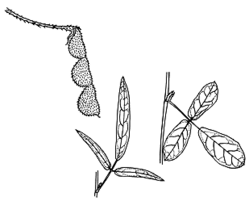Common name: Slender Tick-trefoil
Grona varians (Labill.) H.Ohashi & K.Ohashi APNI* Synonyms: Desmodium varians (Labill.) G.Don APNI*
Desmodium varians (Labill.) G.Don APNI*

Description: Prostrate or climbing herb; stems 15–50 cm long, ± glabrous to sparsely hairy.
Leaves 3-foliolate; leaflets variable, oblong to ± circular, 0.5–4.0 cm long, 5–20 mm wide, apex obtuse to acute, glabrous to sparsely hairy; petiole 6–30 mm long; stipules c. 5 mm long.
Racemes to c. 25 cm long, 4–60-flowered; pedicels 5–15 mm long. Flowers 4–5 mm long, pink to white.
Pod 7–20 mm long; articles 2–6, each 3–4 mm long.
Flowering: almost all year.
Distribution and occurrence: Widespread, chiefly in woodland or eucalypt forest; not common.
NSW subdivisions: NC, CC, SC, NT, CT, ST, NWS, CWS, SWS, NWP, SWP
Other Australian states: Qld Vic. Tas.
Previously included in the genus Desmodium, but molecular data have demonstrated that this genus needs to be greatly divided. An atypical specimen from the Yetman-Warialda area has leaflets to 6 cm long and 3 mm wide (P.G. Kodela, 2009, pers. comm.).
Text by C. Gardner & T. A. James
Taxon concept: Flora of NSW 2 (1991)
APNI* Provides a link to the Australian Plant Name Index (hosted by the Australian National Botanic Gardens) for comprehensive bibliographic data
***The AVH map option provides a detailed interactive Australia wide distribution map drawn from collections held by all major Australian herbaria participating in the Australian Virtual Herbarium project.
|


